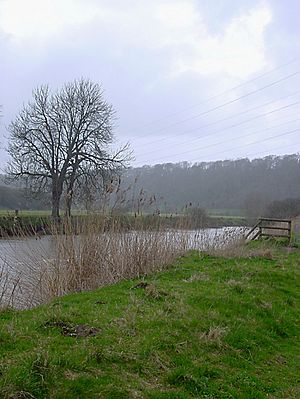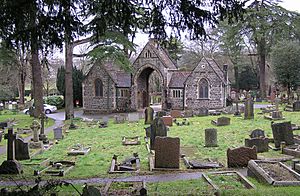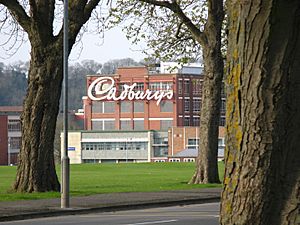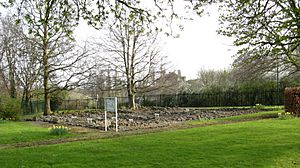Keynsham Roman Villa facts for kids
The Keynsham Roman Villas are ancient Roman homes found near Keynsham in Somerset, England. These villas were built when the Romans lived in Britain. So far, two main villas have been discovered. One of them is believed to be one of the biggest and most amazing Roman homes ever built in Britain! These sites haven't been fully dug up yet. That's because parts of them are hidden under a cemetery, a busy road, and even an old chocolate factory.
Contents
Where are the Keynsham Roman Villas Located?
The remains of these Roman villas are found in an area called the Keynsham Hams. This is a flat, low-lying area near the River Avon. It's just south of the river, close to the town of Keynsham in Somerset.
The Hams is an open space with fields, pastures, and meadows. It has hedgerows and drainage ditches. The River Avon and Cleeve Wood are to the north. A railroad line and the town of Keynsham are to the south. This area is important for nature. It's a "Floodplain Grazing Marsh," which means it has unique habitats for plants and animals.
A large building, the Somerdale Chocolate Factory, stands at the east end of the Hams. It was built between 1923 and 1935. The factory closed in 2011 and was sold in 2012. Now, it's being turned into a new housing community.
How Were the Roman Villas Discovered?
The Roman villas in Keynsham Hams were found over many years. Each discovery happened because of new building projects.
The Bristol to Bath Road Discovery
In the 1700s, a major road was built from London to Bath and Bristol. This road, called the "Great Bath Road," went right over the western and southern parts of one of the Roman villas. The road was built on a high bank, covering the ancient remains.
The Victorian Cemetery Digs
The first big discovery of Keynsham's Roman villas happened in 1877. The local church needed more space for burials. So, they bought land in the Hams to create the new Durley Hill Cemetery.
When workers dug trenches for new buildings, they found a flat floor made of white tesserae. These are small stones used to create mosaics. It turned out these mosaics were part of a very important Roman villa. This villa had at least 30 rooms and 10 complete mosaics!
Even though it was a huge Roman site, burials started almost right away. They continued for 40 years. From 1922 to 1924, a team of archaeologists worked at the cemetery site. They uncovered 17 rooms. They managed to save 10 amazing mosaics from the 4th century. Sadly, the rest of the site was destroyed to make space for more burials.
The Somerdale Chocolate Factory Discovery
In 1922, the Fry's chocolate factory chose Keynsham for its new location. As they dug the foundations for the factory, they found a second, smaller Roman villa. They also found two stone coffins with male and female skeletons inside.
This exciting discovery caught everyone's attention. It even led to the archaeological digs at the cemetery site from 1922-24. However, the factory builders didn't want to move their plans. So, the Roman villa was dug up and rebuilt near the factory entrance. The rest of this second villa is now buried under the factory's foundations.
The factory did create a museum in a small building near its entrance. This museum used to display Roman artifacts and the mosaics saved from the cemetery site.
What Were the Villas Like?
The Grand Villa
The villa found under the Durley Hill Cemetery and the A4 road might be one of the most magnificent villas ever built in Britain. Some experts even compare it to a small palace!
Archaeologists believe this villa might have belonged to a high-ranking retired army officer or a government official. It had over 30 rooms. Some rooms had hypocaust heated floors, which were like ancient central heating systems. There were also many beautiful and expensive mosaics.
The rooms were connected by a veranda. This was a covered walkway supported by columns that went around three sides of a courtyard. An altar base from 155 AD was found here. It had an inscription that showed devotion to the Roman emperor and the god Silvanus.
The Somerdale Villa
The Somerdale Villa was much smaller than the grand villa. It was square-shaped, about 50 feet (15 meters) on each side. It had 8 rooms, including a special bathing area.
More Roman Buildings in Keynsham Hams?
In 2012, a new archaeological survey was done. It found 15 more Roman buildings hidden under the fields of Keynsham Hams. There was even a central road running through them.
This discovery makes archaeologists think that Keynsham might be the lost Roman settlement of Trajectus. "Trajectus" is a Roman word for "bridgehead," meaning a crossing point over a river. Finding so many Roman buildings, in addition to the two villas, makes this idea much stronger!





